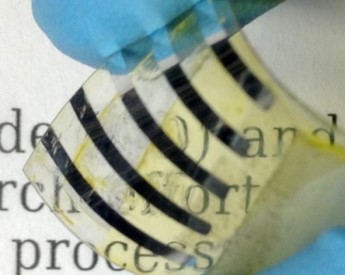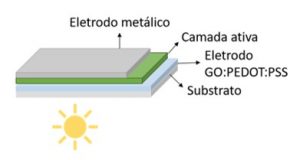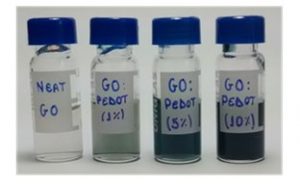
They are lightweight, thin and flexible. They can be manufactured on an industrial scale using simple, low-cost processes. Organic solar cells have several advantages and appeals, but still represent challenges to researchers, especially in the field of materials. These devices that transform sunlight into electricity owe their name to the use of organic materials (polymers or carbon-based molecules) in the active layer, responsible for absorbing light. But the other layers of the “sandwich” that constitute an organic solar cell are also very important, especially the electrodes, which are in charge of collecting the electrical charges produced by exposure to light.
In Brazil, three groups of researchers combined their skills and developed collaborative research that brought an important contribution for developing electrode materials for organic solar cells. The recently published work was coordinated by the researcher Maria Luiza M. Rocco, professor at the Institute of Chemistry at the Federal University of Rio de Janeiro (UFRJ).
Organic solar cells need electrodes that, in addition to being good conductors of electrical charges, are transparent to allow light to pass through the active layer, like windows. Unfortunately, there are few materials that combine good conductivity and transparency. One of them is indium tin oxide (ITO). Thin films of ITO deposited on glass substrate are, until now, the most used electrode in organic solar cells, in addition to being widely used in electronic screens and other devices on the market. “In the mid-term, this standard electrode will need to be replaced, and scientists are diligently trying to effectively replace it,” says Professor Maria Luiza. In fact, the ITO film production process is expensive, and indium is a scarce material in the earth’s crust. In addition, these electrodes are not fully flexible.

Thus far, the leading alternative to ITO is PEDOT:PSS, a polymer blend that allows the manufacture of conductive and transparent films. By combining this material with graphene oxide (GO), it is possible to obtain a composite material which conductivity not only is higher than that of pure polymer but also can be further increased by treating the material. In addition, GO:PEDOT:PSS films can adapt to the roll-to-roll system, that is the favorite for production of organic solar cells on an industrial scale. In this system, the different layers are printed or deposited on a flexible substrate (for example, plastic). The substrate is rolled up at the beginning of the production line, unrolled to receive the layers and rolled again at the end, with the material almost ready to be used as a solar panel.
Detailed analysis
In the work coordinated by Professor Maria Luiza, the researchers carried out a systematic study of different films, using spectroscopic techniques. They analized samples of pure PEDOT:PSS and of graphene oxide with different proportions of PEDOT:PSS (1, 5 and 10%). In addition, samples from each of these groups were treated by cooling them to -196 ° C (liquid nitrogen temperature) until reaching thermal equilibrium and then returned to room temperature.

The objective was to understand the relationship between the structure and properties of each of the films, and to evaluate which of the combinations would allow greater electron mobility and, therefore, a better performance of the material as an electrode for organic solar cells.
Initially, graphene oxide was synthesized by the Materials Chemistry Group at the Federal University of Paraná (UFPR), led by Professor Aldo J. G. Zarbin. Then, members of the Laboratory of Nanostructured Devices, also from UFPR, developed the mixtures, prepared the films and studied the optical, electrical and heat treatment properties, under the coordination of Professor Lucimara S. Roman. Finally, the group of Professor Maria Luiza M. Rocco, from UFRJ, carried out spectroscopic studies at the Multi-User Photoelectron Spectroscopy Laboratory at UFRJ and at CNPEM’s National Synchrotron Light Laboratory (LNLS). The project had also participation of a representative from CSEM Brazil.
“The possibility of using synchrotron light was fundamental for understanding the electronic, morphological and transport properties of these new materials to be used as electrodes in optoelectronic devices,” states Professor Maria Luiza. Spectroscopic studies included differentiated analysis of the surface and bulk of the films, showing different characteristics in each region of the samples.
The study showed that cooled graphene oxide samples with PEDOT:PSS (5%) would better perform as solar cell electrodes. “The introduction of an insulating material (GO) in a conductor (PEDOT:PSS) increased the conductivity of the latter by two orders of magnitude,” reveals professor Maria Luiza. Cheaper than PEDOT, the graphene oxide used in the electrodes would lower the cost of the devices. The treatment carried out also helped to improve the conductivity of the material, by organizing the molecules so that it facilitates the displacement of electrons.
The study is part of Soheila Holakoei’s PhD research in Chemistry, defended at UFRJ in 2019, under the guidance of Professor Maria Luiza. The study received funding from LNLS-CNPEM and from Brazilian agencies Faperj (Rio de Janeiro), CNPq, CAPES and Finep.

Paper: Conformational and Electron Dynamics Changes Induced by Cooling Treatment on GO:PEDOT:PSS Transparent Electrodes. Soheila Holakoei, Amanda Garcez Veiga, Cássia Curan Turci, Matheus Felipe Fagundes das Neves, Luana Wouk, João Paulo V. Damasceno, Aldo J. G. Zarbin, Lucimara S. Roman, and Maria Luiza M. Rocco. The Journal of Physical Chemistry C. 2020 124(49), 26640-26647. DOI: 10.1021/acs.jpcc.0c07827
Contact: Prof. Maria Luiza M. Rocco – luiza@iq.ufrj.br.
